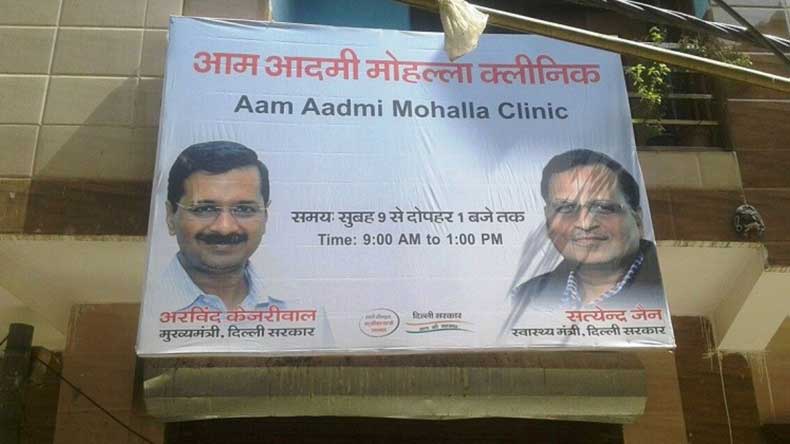The Delhi Health Department is waiting for the new Lieutenant Governor’s office to pass the file on the setting up of mohalla clinics at school campuses, which his predecessor Najeeb Jung had rejected, as the 31 March deadline approaches for opening 1,000 such clinics in the national capital.
Minister of Health, Satyendra Jain, told The Sunday Guardian that they have filed responses to the queries put by former Lieutenant Governor Najeeb Jung and are waiting for the current office to clear the file. Jung had stalled the project citing objections to the government’s plan of opening mohalla clinics in over 300 government schools due to restrictions under the Delhi School Education Act.
Currently, over 110 mohalla clinics providing primary healthcare services comprising free outpatient consultations and free medicines and diagnostics, have been set up across Delhi. The Aam Aadmi Party (AAP) had set a target of opening 1,000 of them by the end of 2016, but due to objections from the Delhi Municipal Corporation Department (MCD) and the LG’s office, the deadline was extended.
On being asked if the Aam Aadmi Mohalla Clinic (AAMC) project would see the light of the day by March end, the Minister of Health sounded optimistic and said that most of the equipment needed to run the clinics is being readied quickly, and that only the makeshift buildings remain to be constructed to put arrangements in place.
“It takes just two to 10 days to set up arrangements in a makeshift establishment if the major work of organising the right equipment is done. We opened one in Tilak Nagar on 10 January which took only two days to make. We’re also looking to acquire more government spaces. We hope the new LG clears the file soon,” he told this correspondent.
Meanwhile, the Municipal Corporation of Delhi (MCD) and the Delhi government continue to be at loggerheads on the opening of the clinics on roadsides and footpaths. The MCD had demolished makeshift clinics functioning out of porta-cabins on the roadside in north Delhi in September 2016. Dr Sanjeev Nair, Mayor of the North MCD, told The Sunday Guardian that the clinics were brought down because the Delhi government hadn’t sought permission from the MCD regarding the same. He also called the AAP’s move of setting up clinics on roadsides an “election gimmick”.
“Footpaths are for people to walk. Opening a clinic on a footpath not only violates laws related to building construction, but creates unnecessary chaos too,” he told this correspondent. He said the AAP is building clinics at places where they are not required. “They (AAP) have set up a clinic in Paschim Vihar where there are already three dispensaries functioning—one run by the MCD, and the other two by the Central Government and the Delhi Government respectively. Why don’t they open clinics where they are actually needed?” he asked.
Jain hit out at the MCD, saying it allows illegal constructions, public toilets and garbage dumps to be set up on the roadsides, but objects to clinics that the government is building for the welfare of the poor. The government, according to an AAP functionary and the Health Minister, has also been trying to start clinics on government premises rather than rented spaces for a “long-term sustainability”, but a paucity of government land and the difficulty to acquire it have proved to be the roadblocks.
The Municipal Corporation Department is of the view that the staff of Mohalla Clinics, which, according to public health expert Dr Chandrakant Lahariya, comprises one doctor, one nurse, one lab technician and one pharmacist, is not sufficient. Not one of the three mohalla clinics that The Sunday Guardian visited had pharmacists to dispense medicines.
AAMCs had attracted flak from certain health activists for presenting a “new wine in an old bottle” because the basic consultation that the AAMCs provide are already being provided by the existing 300 government dispensaries free of cost. Nair said he believes more effort should be channelled into making the dispensaries and other existing facilities better rather than spending the government money on new clinics.
Lahariya, who has been involved in the designing of mohalla clinics since the inception of the project, said that AAMCs have better design than dispensaries.
“The basic difference is of the design. Either the dispensaries are not used at all or they are overcrowded. Often there is more infrastructure than required which is inefficient use of resources. On the top of that, these are not adequately staffed and the referral linkages are missing,” he said.
He said that he felt there was a merit in utilising existing dispensaries and polyclinics to establish mohalla clinics, and this should not lead to a “new vertical service delivery mechanism”.
Jain said that to cater to the demand of the population of Delhi, the number of dispensaries are not enough.
“The city needs at least 2,000 dispensaries to attend to the demand of primary healthcare, particularly among the poor. Doctors at AAMCs attend between 60-100 patients daily. This obviously shows that the clinics are needed and are working amongst the people belonging to both the lower and higher income group,” Jain told this correspondent.
He said the Delhi government will open three crore OPDs (Out Patient Departments) and will plan to connect the AAMCs to polyclinics soon.

